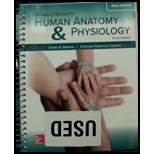
Laboratory Manual For Human Anatomy & Physiology
4th Edition
ISBN: 9781260159080
Author: Martin, Terry R., Prentice-craver, Cynthia
Publisher: Mcgraw-hill Education,
expand_more
expand_more
format_list_bulleted
Concept explainers
Question
Chapter 11, Problem 4.4A
Summary Introduction
To fill:
The correct term in the given blank.
Introduction:
There are two types of sweat glands; merocrine and apocrine glands. Merocrine sweat glands, the most numerous types produce perspiration that serves primarily to cool the body.Apocrine sweat glands respond especially to stress and sexual stimulation.
Expert Solution & Answer
Want to see the full answer?
Check out a sample textbook solution
Students have asked these similar questions
Green Algae, as a group, is actually paraphyletic with one subgroup more closely related to higher plants than the other. Which of the following green algae groups is more closely related to higher plants:
a. Charophyceans
b. Chlorophyceans
c. Rhodophyta
d. Xanthophyceans
A single-celled green algal genus that is motile with 2 flagella, has a cup shaped chloroplast, and an eyespot:
a. Volvox
b. Chlamydomonas
c. Euglena
d. Codium
A[n] ___ is produced by members of the Myxomycota when there is a lack of moisture.
a. plasmodiocarp
b. aethalium
c. sclerotium
d. plasmodium
Chapter 11 Solutions
Laboratory Manual For Human Anatomy & Physiology
Ch. 11 - Which of the following is not a function of the...Ch. 11 - The two distinct skin layers are the epidermis and...Ch. 11 - Apocrine sweat glands are located in __________...Ch. 11 - The hypodermis is composed of __________ tissues....Ch. 11 - The _________ of the epidermis is only present in...Ch. 11 - Frequent cell division occurs in the...Ch. 11 - Prob. 7PLCh. 11 - Thick skin of the palms and soles contains five...Ch. 11 - Figure 11.6 Label the features of the skin.Ch. 11 - Match the structures in column A with the...
Ch. 11 - How does the skin of your palm differ from that on...Ch. 11 - Describe the differences you observed in the type...Ch. 11 - Explain how a hair is formed.Ch. 11 - What portion of the nail plate is not visible on...Ch. 11 - Complete the following chart, and then circle the...Ch. 11 - How do the cells of stratum corneum and stratum...Ch. 11 - State the specific location of melanin observed in...Ch. 11 - Which is darker, the anterior forearm or the...Ch. 11 - What special qualities, due to the presence of...Ch. 11 - How is the structure of the thick skin of the...Ch. 11 - What part of the hair extends from the hair...Ch. 11 - In which layer of skin are sebaceous glands found?Ch. 11 - How are sebaceous glands associated with hair...Ch. 11 - Prob. 4.4ACh. 11 - Which type of sweat gland is most important in...Ch. 11 - Sketch a vertical section of human skin, using the...
Knowledge Booster
Learn more about
Need a deep-dive on the concept behind this application? Look no further. Learn more about this topic, biology and related others by exploring similar questions and additional content below.Similar questions
- Which of the following is not true about the life-cycle of Fucus. a. 8 eggs per oogonium b. 64 sperm per antheridium c. eggs are flagellated d. sperm are flagellatedarrow_forwardGreen Algae, as a group, is actually paraphyletic with one subgroup more closely related to higher plants than the other. Which of the following green algae groups is more closely related to higher plants: a. Charophyceans b. Chlorophyceans c. Rhodophyta d. Xanthophyceansarrow_forwardCertain toxic terpenoids in this group is thought to deter herbivory but may also have some anti-tumor activity? a. green algae b. brown algae c. red algae d. golden algae e. none of thesearrow_forward
- In the cellular slime molds, the most common phase is: a. plasmodium b. pseudoplasmodial c. single cells as myxamoebae d. moundingarrow_forwardWhich of the following descriptive terms does not describe Hydrodictyon? a. colonial b. nonmotile c. 1 large reticulated chloroplast in each cell d. all of these describe Hydrodictyonarrow_forwardWhich of the following does not apply to Chara? a. "stoneworts" b. isogamous c. calcified walls d. apical growth with an axis and branchesarrow_forward
arrow_back_ios
SEE MORE QUESTIONS
arrow_forward_ios
Recommended textbooks for you
 Medical Terminology for Health Professions, Spira...Health & NutritionISBN:9781305634350Author:Ann Ehrlich, Carol L. Schroeder, Laura Ehrlich, Katrina A. SchroederPublisher:Cengage LearningUnderstanding Health Insurance: A Guide to Billin...Health & NutritionISBN:9781337679480Author:GREENPublisher:Cengage
Medical Terminology for Health Professions, Spira...Health & NutritionISBN:9781305634350Author:Ann Ehrlich, Carol L. Schroeder, Laura Ehrlich, Katrina A. SchroederPublisher:Cengage LearningUnderstanding Health Insurance: A Guide to Billin...Health & NutritionISBN:9781337679480Author:GREENPublisher:Cengage

Medical Terminology for Health Professions, Spira...
Health & Nutrition
ISBN:9781305634350
Author:Ann Ehrlich, Carol L. Schroeder, Laura Ehrlich, Katrina A. Schroeder
Publisher:Cengage Learning

Understanding Health Insurance: A Guide to Billin...
Health & Nutrition
ISBN:9781337679480
Author:GREEN
Publisher:Cengage



